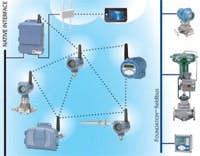From Wireless to Seamless
To sustain business performance in today’s complex and competitive environment, continuous innovation is critical. And within the global process industries, this innovation increasingly relies on collaborative decision-making based on the very latest information—available at all levels of the enterprise, within and across organizational boundaries. In fact, companies will rely on better information integration to provide a critical productivity boost in view of today’s shortage of skilled workers.
Fortunately, the advent of wireless technology and standards for in-plant use has coincided with the development of complementary tools to ease integration tasks. Indeed, the seamless integration of wireless into current plant architectures holds the potential to improve productivity dramatically by providing ready access to better information.
Meanwhile, the integration of wireless networks into your current plant automation hierarchy may be simple—but in most cases it’s not yet entirely automatic. So then, a brief review of the current options for making your wired and wireless worlds work well together.
| See "Primary Wireless Integration Protocols" Table |
Through the Gateway
As with the transition between any two disparate networks, the integration of wireless into a host control or information system relies on a gateway to translate, for example, WirelessHART into Ethernet.
When adding a wireless network to an existing process unit, it’s typically the interface requirements of the host system that will dictate what type of gateway interface will be needed. With the connectivity options listed below, the gateway can be integrated with a wide range of host systems, including Emerson’s DeltaV and Ovation control systems, Emerson’s AMS Suite asset management application, as well as a wide range of programmable logic controllers, process historians and other legacy control systems.
Go Native
The best-case scenario for wireless integration is a host system such as Emerson’s DeltaV, Ovation or AMS Suite, the latest generations of which now include native support for wireless devices. Indeed, for users of these systems no integration per se is required—wired and wireless field devices appear transparently on the system without requiring special wireless or communication know-how.
In the latest iterations of DeltaV and Ovation, the Smart Wireless Gateway can even be “auto-sensed” and “autoconfigured” for quick and easy start-up and commissioning. Essentially, the gateway becomes just another control network node. In addition, HART alerts from WirelessHART devices pass directly through to the AMS Suite: Intelligent Device Manager, eliminating the need for an additional network.
Nu-West Industries’ phosphate-based fertilizer plant in Soda Springs, Idaho, U.S., is among those process manufacturers leveraging this native capability. Remote tank level measurements feed wirelessly through a Smart Wireless Gateway into the plant’s DeltaV automation system where Emerson’s AMS Suite: Intelligent Device Manager application recognizes readings that are out of norm, enabling operations to take action to control reactions in the tank.
Networks
Emerson Process Management’s Smart Wireless architecture relies on industry-standard WirelessHART and WiFi networks to communicate seamlessly with wireless devices. To operators and maintenance personnel, wireless devices appear just like wired ones.
Serial Limitations
If your application uses a serial Modbus communication link, first verify that the host system has available connection capacity. A good estimate for the number of Modbus registers required is three times the number of data points to enable remote monitoring of the process variable and device status indicators. It’s also important to note that with serial systems, security measures are limited to physical isolation of the components; data cannot be encrypted and access cannot be managed due to protocol limitations.
Hunt Refining in Tuscaloosa, Ala., U.S., uses a Smart Wireless Gateway to gather wireless temperature measurements from several hot asphalt tanks 400 ft (130 m) away from the control room. In this case, two-wire Modbus connects the gateway to the plant’s control system and AMS Suite application.
“The installation was simple, and the transmitters came up and talked with the gateway as soon as power was applied,” says Dennis Stone, Hunt Refining process control engineer. “The gateway was easily connected to the distributed control system via a two-wire Modbus communication.”
Ethernet Options
Finally, if the host application requires integration via Modbus TCP/IP, OPC or HTML, then either a wireless or wired Ethernet connection is the way to go. Ethernet communications will have fewer restrictions than serial systems, but may require the involvement of your IT department. The IT department can identify the connection point and integrate the gateway through Ethernet firewalls and provide remote access to the gateway. Ethernet also allows the gateway to be managed securely like any other device in an IT network.
Wireless Ethernet provides high bandwidth to handle both diagnostic and measurement data. In fact, with power as the only requirement, you can place the gateway almost anywhere that’s in range of the devices as well as the host connection. For the same reason, it’s easy to move the gateway if needed.



